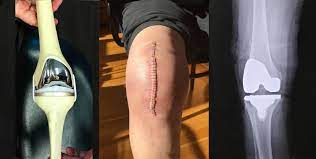Total Knee Replacement

Knee is considered to be one of the most important joint in the body as it plays a leading role in bearing the body weight. Knee is the most common joint that gets worn out with age. Patients with diseases such as osteoarthritis, hemophilia, gout, rheumatoid arthritis etc. may also require knee replacement. When the knee joints get damaged, it is necessary to be replaced. The prosthesis used in joint replacements varies depending on patient factors and cost. The replaced knee can last for upto twenty five years depending on the activity level of the patient.
Indications
- Severe knee pain restricting day to day activities like walking, climbing stairs, using the commode etc.
- Night pains disturbing your sleep.
- Deformity in knees.
- Restricted knee bending and stiffness.
- Failure of other treatments modalities like physiotherapy and medications.
Advantages :
The realistic results that the patient can hope to achieve following a replacement surgery are
- Significant pain relief
- Improved ambulatory status
- Straighter knee free from deformity
- Bending upto 100 degrees (Can go upto 130degrees) Active lifestyle
Limitations :
Patient should not do activities like jumping , sprinting, contact sports, repeated squatting, sitting on floor & use of Indian toilet to avoid early damage to implanted knee.
Total joint arthroplasty is indicated when all compartments in the knee are worn out. This is the most commonly done surgery and has good results in terms of pain and activity level.
Patient selection:
Patients with the above indications are ideal candidates for joint replacement. Age is not a criterion for joint replacement but symptoms are. Patients with associated co-morbidities like diabetes, hypertension, heart conditions, lung and urinary tract infections, dental caries etc. need a complete pre operative evaluation before deciding on surgery.
Implant selection:
A variety of implants are available in the market for joint replacement surgeries. They are available in stainless steel, cobalt chromium alloys, titanium alloys, tantalum alloys, zirconium alloys and the new oxinium implants. Different prosthetic designs with rotating platforms to promote more knee bending are also available. Implant selection is primarily dependent on patient factors and expectations. The cost also plays an important role in our society.
The surgery:
The normal inpatient time in the hospital varies from 3 to 7days. The stages involved in preparing for the surgery are
- Pre operative
- Intra operative
- Post operative
- Home care
Pre operative work up:
Pre operative work up starts with a Consultation with the Orthopaedic Surgeon. It includes a detailed history, general physical examination, knee joint examination, x rays, blood investigations, ECG, Echo and patient counseling. Patient will additionally have to meet a Physician, a Cardiologist, an Anaesthetist and sometimes a Gynaecologist for pre operative assessment of their body condition. Blood may be required in the pre, intra or post operative period in patients with low blood levels. Pre operative work up can be done as inpatient or outpatient. Once the patient is fit for surgery, he or she is admitted for undergoing the procedure.
Intra operative period:
After admission, the patient is kept on empty stomach for a minimum period of six hours prior to surgery. The knee joint is prepared an hour before surgery and the patient is shifted to the operation theater half hour before the scheduled time. The surgery last for a period of about 2 hours. The anesthesia routinely administered is spinal or epidural anesthesia where the patient is awake during the procedure but both the legs numb below waist level. The other type is the general anesthesia where the patient is put to sleep.
After giving anesthesia, an adequate portion of the quadriceps muscle is detached from kneecap. The proximal end of tibia(leg bone) and the distal end of femur(thigh bone) is now exposed by displacing the kneecap to one side. The damaged bone ends are trimmed, necessary cartilages and ligaments are removed. Metal components are wedged onto the bone using an appropriate cementing material. The wound is closed with stitches. After the surgery patient is shifted to the post operative recovery room. Blood may be given in the operation theater or in the post operative ward.
Post operative period:
Day 1: The patient is usually made to sit and stand on the 1st post operative day with a knee brace. Diet is normalized. Antibiotics and thromboprophylaxis are continued. If they are comfortable, they are even made to walk a few steps. Blood may or may not be given depending on the blood loss. Pain is controlled by epidural catheters which are retained for 2 days.
Day 2: Wound is inspected and dressing is changed on 2nd day. The patient is made to walk further more with support of a walker and brace. They are given commode training and knee exercises. Recovery is generally quick and one can perform his/her daily activities but with some care. Injections are changed to tablets.
Day 3 to Day 5: It involves more physical activity and knee bending. Stairs climbing is initiated. Patient is discharged once mobilization is satisfactory.
Home care:
Home care involves wound care and home exercises The success of a replacement surgery depends a lot on rehabilitation. Patient has to do simple exercises which are taught during hospital stay at home for around 8-10 days. The dressing should not be disturbed and should be water free. Dressing is changed after 5 days and sutures are removed after 14 days.

